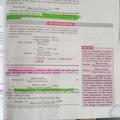Question 4 :
<div>The oxidation state of the underlined element in the given compound is:<br/></div>$\underline{C_{12}}H_{22}O_{11}$
Question 5 :
<div>Find the oxidation number of nitrogen in each case :<br/></div><div><br/></div>$ N$ in $NH_3, NH_2OH, NaN_3$ and $NH_4NO_2$.
Question 6 :
If $4$ mol of $Br_2$ undergo a loss and gain of a total of $6$ mol electrons to form two new oxidation state of $Br_2$. How many moles of $Br_2$ acts as reductant?
Question 7 :
Assertion: The reaction between $N{ H }_{ 3 }$ and $Mn{ O }_{ 4 }^{ \ominus }$ occurs in an acidic medium.<br>$N{ H }_{ 3 }+Mn{ O }_{ 4 }^{ \ominus }\longrightarrow Mn{ O }_{ 2 }+N{ O }_{ 2 }$
Reason: $Mn{ O }_{ 4 }^{ \ominus }$ is reduced to $Mn{ O }_{ 2 }$ in acidic medium.
Question 8 :
A compound contains three elements $X, Y$ and $Z$. The oxidation number of $X, Y$ and $Z$ are $+3, +5$ and $-2$ respectively. The possible formula of the compound is:
Question 9 :
$\displaystyle HCl\left( aq \right) +Zn\left( s \right) \rightarrow Zn{ l }_{ 2 }\left( aq \right) +{ H }_{ 2 }\left( g \right) $<br/>In the above reaction $\displaystyle HCl\left( aq \right) $ play a role as :<br/>
Question 10 :
The non-stoichiometric compound $Fe_{0.94}O$ is formed when $x \%$ of $Fe^{2+}$ ions are replaced by $Fe^{3+}$ ions, then $x$ is:
Question 11 :
The oxidation number of underlined element in  $\displaystyle Na_{2}\left [ \underline{Fe}\left ( CN \right )_{5}NO^{+} \right ]$ compound is :
Question 12 :
Identify the case (s) where there is change is oxidation number.
Question 13 :
In which of the following compounds, nitrogen exhibits highest oxidation state?
Question 14 :
During oxidation of ferrous sulphate using mixture of dil. $H_2SO_4$ and potassium dichromate; oxidation state of chromium changes from: <br/>
Question 15 :
When potassium dichromate, ${K}_{2}{Cr}_{2}{O}_{7}$ is converted into ${K}_{2}Cr{O}_{4}$, the change in oxidation number of chromium is :
Question 16 :
$Cu(s) +NO_{3}^{-}(aq) +H^+(aq) \rightarrow Cu^{2+}(aq) +NO_2(g) +H_2O(l)$<br/>Select the correct statement regarding above reaction.
Question 17 :
<div>Find the oxidation number of elements in each case .<br/></div><div><br/></div>$O$ in  $ O_2,O_3, OF_2$ and $BaO_2$.
Question 19 :
In the reaction $H_2O_2 + Na_2CO_3 \rightarrow Na_2O_2 + CO_2 + H_2O$, the substance undergoing oxidation is:
Question 22 :
The oxidation number and coordination number of $M$ in the compound, $[M(SO_4)(NH_3)_5]$ will be:
Question 23 :
Assertion: $HN{ O }_{ 3 }$ acts only as an oxidising agent while $HN{ O }_{ 2 }$ acts both as an oxidising agent and a reducing agent.
Reason: The oxidation number of $N$ in $HN{ O }_{ 3 }$ is maximum.
Question 25 :
A compound contains atoms $X,\ Y$ and $Z$. The oxidation number of $X$ is +2, $Y$ is +5 and $Z$ is -2.<br>The possible formula of the compound is:
Question 26 :
Which is not true about the reaction of $KO_2$ with $CO_2$ and $H_2O$?
Question 28 :
When a piece of sodium metal is dropped in water, hydrogen gas evolved because:
























